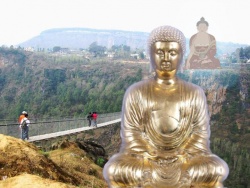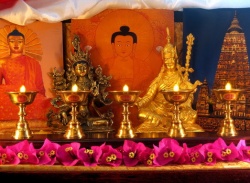Goodness
We could say there are three dimensions to the real: a finite, temporal dimension, an infinite, timeless dimension and a narrative, mythical dimension. Correspondingly, there are sciences and arts of the finite, sciences and arts of the infinite, and sciences and arts of the narrative.
The teachings on Dzogchen draw from all three dimensions – in fact, it is a remarkable integration of all three of these.
In Dzogchen there are all the practical teachings of Buddhism, and there are all the narrative teachings of Buddhism. But it is the addition of the infinite, timeless dimension that makes these texts and teachings unlike anything else we typically encounter.
How do you suggest infinite reality to minds that are locked into the finite? In the Mahayana one of the ways is to multiply everything in the most extravagant manner possible. We are overwhelmed by innumerable buddhas, innumerable states of perfection, innumerable pure lands.
This is possible because the space of these teachings is a unique space with some unique properties.
For one, it is a space in which whatever you wish comes to be. Space is all accommodating – it contains all possibilities, those imagined and those beyond imagination. What brings a particular possibility to fruition? At the most basic level it is desire or intentionality; it is aspiration.
If you think about it, it is rather uncanny how conveniently even the finite world is set up to accommodate the desires of sentient beings. We do not appreciate this because we are understandably rather spoiled. Over time we have realized hundreds of thousands of desires. We do not think that is anything special. Instead we complain about the few desires that have been frustrated.
Why are desires frustrated? We could speculate on this at some length, but one possibility may be that we do not have unity of desire, strength of desire arising from all parts of our being – that is to say, we want and don’t want something at the same time – so at some level we contradict ourselves. It is that inner indecisiveness of will, that inner contradiction in our own being that perhaps is the largest obstacle we face.
Purification is the clarification of intentionality. That is something we achieve through prayer and meditation.
Of course there is an irony to this – as we begin the work of clarification of desire, we may discover that we don’t really want what we thought we did. We may discover that all desire carries with it a karmic price tag, at the very least keeps us entangled in the process of desiring itself, continually grazing in the fields of desire without ever lifting our heads up to see what is around us.
Contemplatives have always realized the superiority of desirelessness. Desire binds us to the wheel of fortune. Whatever goes up, comes down. Whatever rises, falls. In Buddhism the wheel of fortune is called samsara. It is notorious for being endless, leading nowhere and causing only suffering. This is why the Greek Sage Epicetus advised, “Desire only that everything happen exactly as it does.”
Yet as worldly people it is hard for us to put such sagely advice into practice. Deep down we have some really strong longings, many such longings, and we are very attached to all of them. For this reason it is easier if we just reduce our desires, rather than eliminate them altogether. We must ask ourselves what it is we really want. What do we really believe will guarantee, without a doubt our happiness, now and forever?
We have all heard of tales where by some great luck one is given the chance to make one wish for whatever one wants. Obviously there are many things one could wish for, but if are clever, we realize that the one thing to wish for would be a wish-fulfilling jewel, that is, something that allows us to continue wishing for whatever we want. That would be the smart thing to wish for.
The premise of Dzogchen is that we already have this jewel and don’t realize it. It is our own inherent goodness. Goodness is the wish-fulfilling jewel. Wherever there is goodness there is joy and happiness, wherever it is obscured or lacking there is no happiness, and wherever it is tenuous and partial, happiness is only tenuous and partial.
This is the logic of the Mahayana and Dzogchen practices. In the Mahayana pure land practice we are given a way to drive all our desires into one desire – the desire for rebirth in the pure land of the buddhas. In Dzogchen we desire simply to experience completeness of intrinsic awareness itself. These are not different desires.
In the world of finite or partial realities, the notion that a practice of just calling on the name of Amitabha would open up the door of paradise is a completely absurd notion. But in the world of complete reality – where the infinite has sway – it makes perfect sense. It is a transcendental sort of sense to be sure, one that requires a certain faith in the unseen, the invisible, the nonlinear, and the non-finite.
It is the Mahayana view that no one ever becomes so closed, so jaded, so hopeless that they lose the spark of the infinite altogether. Buddha nature is present in everyone, even if obscured by eons of obscurations. At any moment we can turn to the open space of pure awareness that is within us and glimpse the transcendent.
To live the transcendent each moment of our life – that is not so easy, but to glimpse it, that is not too hard. If we start asking ourselves what it is we really want, eventually we will find that our deepest and purest aspiration – our deepest desire is for goodness itself. There is nothing better.
Plotinus, the great ancient philosopher, would never make any statement about ultimate reality other than to say it was good. That is the only description that speaks to the whole of transcendent reality, not to its manifestation in the realm of partialities.
Goodness makes every other desire desirable. And even more remarkable — just by uncovering that one desire, voicing that one desire, we set into motion the inevitable fulfillment of that desire. If we desire goodness, we will find goodness. If we desire to become Buddha, we will become Buddha. That is the force of aspiration. When we sift through all the partialities of our being, when we lay the competing claims for our attention to rest, and get down to the essential, then our faith comes alive, and we touch the heart of goodness that has been present, everywhere since the beginning of time.
Goodness is not something we can take to the bank and convert into cash. It has no physical substance. Who has ever seen goodness? Actuality, we all have seen goodness. We have felt it and know that it is real. Invisible, yet real. In its reality it has the three dimensions we mentioned before: there is finite goodness, infinite goodness and there is a narrative dimension to goodness. Mahayana and Dzogchen are just that – narratives of goodness.
The goodness that stills desire, the goodness that enlightens us is not finite goodness or narrative goodness, but infinite goodness. When we think of the buddhas, and say the mantras of the buddhas, if in that moment we are happy it is because we are touching goodness in all its dimensions. There is infinite goodness in the buddhas and in their mantras. That is why when you think of them or say their names there is a little jump in your heart. Invisible, yet real. That is what the infinite is like.


